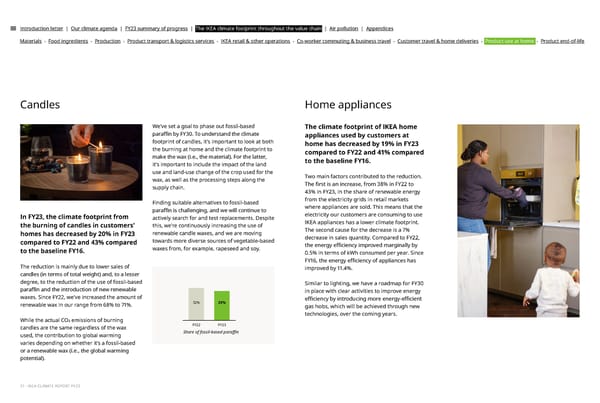Introduction letter | Our climate agenda | FY23 summary of progress | The IKEA climate footprint throughout the value chain | Air pollution | Appendices Materials - Food ingredients - Production - Product transport & logistics services - IKEA retail & other operations - Co-worker commuting & business travel - Customer travel & home deliveries - Product use at home - Product end-of-life Candles Home appliances We've set a goal to phase out fossil-based The climate footprint of IKEA home para昀케n by FY30. To understand the climate appliances used by customers at footprint of candles, it's important to look at both home has decreased by 19% in FY23 the burning at home and the climate footprint to compared to FY22 and 41% compared make the wax (i.e., the material). For the latter, to the baseline FY16. it's important to include the impact of the land use and land-use change of the crop used for the Two main factors contributed to the reduction. wax, as well as the processing steps along the supply chain. The 昀椀rst is an increase, from 38% in FY22 to 43% in FY23, in the share of renewable energy Finding suitable alternatives to fossil-based from the electricity grids in retail markets where appliances are sold. This means that the para昀케n is challenging, and we will continue to electricity our customers are consuming to use In FY23, the climate footprint from actively search for and test replacements. Despite IKEA appliances has a lower climate footprint. the burning of candles in customers' this, we're continuously increasing the use of The second cause for the decrease is a 7% homes has decreased by 20% in FY23 renewable candle waxes, and we are moving decrease in sales quantity. Compared to FY22, compared to FY22 and 43% compared towards more diverse sources of vegetable-based to the baseline FY16. waxes from, for example, rapeseed and soy. the energy e昀케ciency improved marginally by 0.5% in terms of kWh consumed per year. Since FY16, the energy e昀케ciency of appliances has The reduction is mainly due to lower sales of improved by 11.4%. candles (in terms of total weight) and, to a lesser degree, to the reduction of the use of fossil-based Similar to lighting, we have a roadmap for FY30 para昀케n and the introduction of new renewable in place with clear activities to improve energy waxes. Since FY22, we've increased the amount of 32% 29% e昀케ciency by introducing more energy-e昀케cient renewable wax in our range from 68% to 71%. gas hobs, which will be achieved through new technologies, over the coming years. While the actual CO2 emissions of burning candles are the same regardless of the wax FY22 FY23 used, the contribution to global warming Share of fossil-based para昀케n varies depending on whether it’s a fossil-based or a renewable wax (i.e., the global warming potential). 31 - IKEA CLIMATE REPORT FY23
 IKEA CLIMATE Report FY23 Page 30 Page 32
IKEA CLIMATE Report FY23 Page 30 Page 32